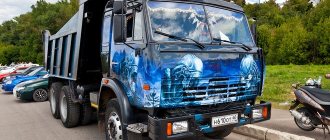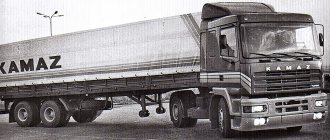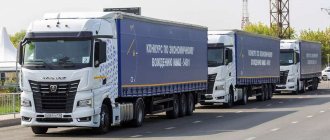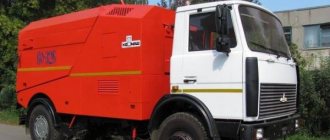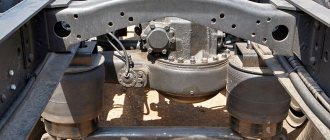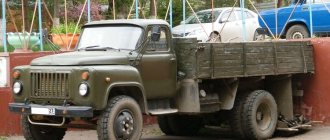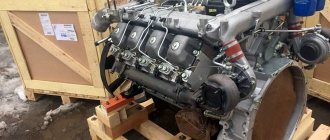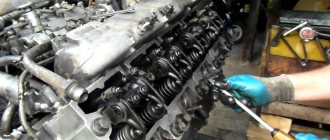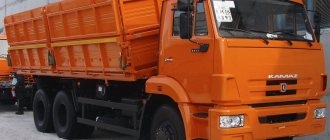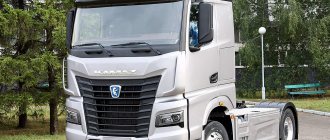You can trace the history of the auto giant by looking at photographs of KamAZ cabs from different years. Over the years, five generations of trucks have been produced from K1 to the modern K5.
Interesting to know! Three books have been prepared and published for the 50th anniversary of the KamAZ enterprise. The “History of KamAZ in documents and photographs” stands out in scale. It describes the events at KamAZ and the history of the construction and development of the city. The book consists of a large number of historical documents:
- Government decrees that began the grandiose construction in 1969.
- Rare photographs taken in the early years of the auto giant's work.
- And many others, including modern documents.
The book can also be read in PDF format.
The history of the legend or the beginning of the production of KamAZ trucks.
The growing economy of the USSR in the 1960s required more modern heavy-duty vehicles. The demand for vehicles with a carrying capacity of 8-20 tons was especially significant. None of the enterprises operating at that time could fully cover this request.
This became the prerequisite for the construction of a new automobile plant in Naberezhnye Chelny. For the construction of the plant, they chose a small (population of less than 30,000 people) settlement on the banks of the large Kama River, in the very center of the European part of the country.
Together with the plant, they began to build a dam and a hydroelectric power station. This provided a large new area with electricity. The auto giant's capacity allowed it to produce 150,000 trucks and 250,000 engines annually.
Over 700 foreign companies and about 2,000 domestic enterprises from 500 cities of the country acted as contractors in the large-scale project. The city's population growth rate in the late 70s and early 80s was about 40,000 people annually, and over time the number of residents increased to 500,000 people.
The first power unit was assembled in 1974, and a year later a serial engine production line began operating.
Interesting to know! The release date of the first KamAZ-5320 truck is February 16, 1976. Its design was based on the ZIL-170 and ZIL-175, developed by the MAZ enterprises and the Yaroslavl Motor Plant in 1967-1969.
KamAZ models and modifications assembled over the entire period of operation of the plant include onboard vehicles, dump trucks, tractors, chassis for special vehicles, as well as racing versions.
Interesting to know! The KamAZ team has won the prestigious Dakar rally 18 times.
Device Features
The cabin of a modern tractor is designed to accommodate three people as comfortably as possible. In addition to the comfortable, soft driver's seat upholstered in high-quality materials, there are auxiliary seats in the cabin. There is no sleeping place in this vehicle. The Kamaz 5320 cabin stands out from its numerous analogues due to its ideal and high-quality thermal protection.
Driver's cabin Kamaz 5320
The Kamaz 5320 cab is equipped with all the necessary measuring and control devices, as well as modern indicators. All this allows the driver to constantly receive information regarding the general condition of the truck. The instrument panel has its own signal system with ideal visibility of all operating scales and main switches. The body has a durable and reliable metal platform, which is equipped with side and rear sides, as well as an opening function.
Dashboard Kamaz 5320
The presence on the market of a wide and varied range of structural elements for a given vehicle will allow for quick replacement in the event of their possible breakdown. Repairing KamAZ 5320 is not particularly difficult and does not require serious material expenditure.
Generations of KamAZ cabs or a chronicle of the release of new models.
From 1976 to 1978, three basic models were produced:
- Ten-ton KamAZ-5511 dump truck.
- Truck tractor KamAZ-5410 with a total weight of 26 tons.
- KamAZ-5320 truck with a carrying capacity of 8 tons.
Their modifications were the ten-ton KamAZ-53212 truck with a wheelbase extended to 3690 mm, the KamAZ-55102 7-ton agricultural dump truck and the KamAZ-54112 truck tractor for a 33-ton road train.
After the commissioning of the second stage of the plant in 1981, they began to produce the 6-ton KamAZ-4310 with a 6x6 wheel arrangement and single-pitch tires.
Interesting to know! In the basic model for the army, the vehicle was equipped with a winch, two fuel tanks and a system for regulating air pressure in the tires to increase the truck's maneuverability on soft soils and off-road. For agriculture, a modification of this series was envisaged - KamAZ-43105 with a lifting capacity of 7 tons.
In the mid-80s, the production of trucks reached high speeds, and in the fall of 1988 the millionth vehicle rolled off its assembly line.
The popularity of KamAZ in the country was great, but technologically the enterprise was inferior to competitors from abroad.
The second generation is K2.
At the end of the 80s, production of the second generation of cars began, which were equipped with both domestic turbocharged engines and imported engines and components. The comfort of the cabins has been increased by increasing their height by 120 mm. Design changes include the new location of the headlights, which began to be installed in the bumper.
Two-axle 4x2 vehicles appeared during the same period. Among them, the KamAZ-5425MA truck tractor especially stood out, namely: a Cummins engine of 235 hp. and a cabin from the Finnish company Sisu.
The third generation is K3.
The production of the third generation of vehicles began in 1995, and the K3 vehicles were based on modernized trucks from the first 6x4 versions. The new generation had the following machines:
- Eleven ton KamAZ-53215.
- Dump truck KamAZ-55111.02.
- KamAZ-54115 is a truck tractor for a 36-ton road train.
- Truck crane on KamAZ-43118 chassis, etc.
From different suppliers, the interior of the third generation of cabins was replenished with two options for the front panel and steering wheel, and three options for instrument panels.
Cabs with a low roof appeared, like in the first generation KamAZ. This design of cabins was required to create special vehicles based on the truck - truck cranes, fire trucks, etc.
Generation of K4 cabins.
The Mercedes-Benz Axor cab is the fourth generation of KamAZ cabs. This includes KamAZ-5490 tractors, as well as dump trucks and special-purpose vehicles.
Situation
Once watching the documentary series “Secrets of Forgotten Victories,” which talked about the creation of unique products and entire complexes in the context of a fierce confrontation between two political systems, I thought that KamAZ also participated in this race during the perestroika years. And my work colleagues and I had the opportunity to become its direct participants.
As the older generation knows, in the Soviet Union a lot was planned for significant dates. And so a proposal arose to prepare a new cabin for the KamAZ-54225 and KamAZ-53225 heavy tractors for the ceremonial rolling off the assembly line of the millionth vehicle, scheduled for October 18, 1988. Record deadlines were allotted!
The most curious thing is that 30 years later, the theme of the “new cabin” is still relevant. What kind of cabs have KamAZs tried on, changing their brand nameplates, but in the 43 years of operation of the enterprise, they made their own cab, created from scratch, only once! But many people don’t know anything about this, and if they do know, it’s not much and not exactly what actually happened.
Perestroika... significant years 1986–1988. A giant design is being built at AvtoVAZ, according to Mikhail Sergeevich Gorbachev), in the hangars of the city of Korolev, Buran is being prepared for space flight, at MAZ they are assembling Perestroika, and at KamAZ they are designing a new cabin for a family of heavy 2-axle vehicles. And in the Soviet Union they are celebrating the 1000th anniversary of the baptism of Rus' - RISE and ACCELERATION are felt in everything. True, it will all end with the collapse of the USSR, and all this will be called “the last convulsions of a colossus with feet of clay.” In my opinion, we were passing the “point of no return,” when events could still have gone according to a different scenario.
It is not known who came up with the idea to produce the millionth KamAZ with a new cab (probably the “perestroika” party activists of the auto giant or someone from the Scientific and Technical Center), but already in the spring of 1987, all divisions of KamAZ had socialist commitments on this topic. This was how it was done: the party said “we must”, the people answered “we will do it”.
At this time, the KamAZ Research and Development Center was undergoing its own “perestroika”. Chief designer Vladimir Naumovich Barun was replaced by his deputy Ramil Andreevich Azamatov, and Semyon Semenovich Yakubov, the former chief engineer of the Automobile Plant (Auto Assembly Plant. And from 1985 to 1987 - director of the KamTZ engine plant under construction in Yelabuga. - Ed.) . The ERA OF MOTORSPORT began at KamAZ!
Since 1976, KhKB employees have developed and manufactured several models for modernizing the KamAZ cab
KamAZ today.
The current generation of KamAZ is K5. In this version, the cabin from the Mercedes-Benz Actros stands out, which is currently installed only on the KamAZ-54901 two-axle truck tractor.
The K5 family of cars received in-line six-cylinder engines with power from 380 to 550 hp. with a declared resource of 1.5 million km.
New technological solutions, modernization and digital transformation of the enterprise, attracting significant investments - all this allows the auto company to produce trucks that meet modern trends in the truck industry.
Application and advantages of the model
Speaking of tanks. Of course, such a successful machine also found application in military service. Special development for the army - Typhoon.
Of course, a lot has changed now, both in the army and in civilian life, but KAMAZ has not yet been forgotten.
Kamaz 5320 is characterized by a large number of positive qualities and characteristics. This makes it possible to use it in a wide variety of fields and industries. High load capacity allows the device to be used for transporting heavy loads. Among the most basic areas of use of the machine are:
- Agriculture.
- In a variety of suburban areas when transporting waste and construction waste.
- On modern construction sites.
- In places where minerals are mined.
- In the quarries.
- In ordinary private companies.
Areas of application KamAZ 5320
The high performance of the equipment allows it to be used in all industrial and construction areas without any problems. Upon careful study of the main technical characteristics, it immediately becomes clear that there is nothing more convenient for short- and long-distance transportation of cargo. The truck feels ideal on city roads and intercity highways.
According to Feng Shui: Mercedes cabins for KAMAZ
Surely many people know that Daimler is going to build a plant for the production of passenger cars near Moscow. Meanwhile, in Naberezhnye Chelny, Mercedes is already building another enterprise: they will make cargo cabins there. And they are intended primarily for KAMAZ vehicles!
At the end of February, the joint venture DAIMLER KAMAZ RUS (“DK RUS”), which is responsible for the production and sales of Daimler trucks and buses, announced the construction of a cab plant in Naberezhnye Chelny - and then the Belarusian MAZ announced the creation of its assembly plant in Vietnam. We quote the Mazovsk press information: “at the request of the local community, the building is being erected according to the principles of Feng Shui.”
So this is the secret of successful production! And we were wondering why our car factories have so many problems... Feng Shui, apparently, is not the same: the conveyor is facing the wrong direction of the world, and the golden Japanese “lucky cat” maneki-neko waving its paw - have you seen those? - not in the assembly shop.
Over the past decades, KAMAZ has tried to adapt cabs from all over the world: Sisu from Finland, DAF from Holland, MAN from Germany, Shaanxi from China. And all to no avail. In 2010, a bet was made on the project of the engineering company DMEC from South Korea, but it did not work either - although a number of experimental trucks with such cabs were still built.
Such a cabin for KAMAZ was developed by the South Korean company DMEC, but the project did not take off
Nowadays, KAMAZ-5490 tractors and a number of other models are equipped with a cabin from the Mercedes Axor model, discontinued in Europe, but from the very beginning it was clear that this solution was temporary: the cabin is cramped, there are only one or two options in the range.
But soon everything will be according to Feng Shui: DK RUS is building a plant in Chelny where they will make 55 thousand cabin frames per year! It is being built in the very heart of the KAMAZ industrial zone, on the site where there was a parking lot for finished cars. The area of the future building is an impressive 59,600 m², the planned number of employees is 790 people. According to the financial director of DK RUS Oksana Karakhova, the plant will be ultra-modern: one hundred robots will be installed here. The exact volume of investment is unknown, but it amounts to hundreds of millions of euros.
This is what the future looks like today
By the way, at the end of 2014, a similar, but more compact plant was opened by the Volvo concern in Kaluga: 90 million euros were invested in its creation, and it is designed to produce 15 thousand cabins for Volvo and Renault trucks per year. But these figures are unattainable in the foreseeable future: in Kaluga last year, a little more than a thousand Volvos were assembled (Renaults are not made there at all yet) and the same number of cabins were manufactured.
Over the past year, DAIMLER KAMAZ RUS produced in Naberezhnye Chelny even more vehicles, but not by much - 1,752 Mercedes trucks. Why, in this case, a plant designed to produce as many as 55 thousand cabins? Because DK RUS, according to forecasts, will receive only 10-20% of this volume, and 80-90% will go to KAMAZ for installation on promising models! By the way, there are no plans to supply cabins “outside” (for export, to Germany).
Welding cabs at the Mercedes truck plant in Wörth, Germany: they promise that in Chelny the level of automation will be similar
There are discussions on the Internet about the fact that they are giving us cabs from 20 years ago... But no: the cabs are the most modern, 2011 model, with the designation SFTP (Strategic Future Truck Program) - they are now equipped in Germany with the long-haul Actros MP4 and the construction Arocs .
Of course, the Chelny range will not be as wide as the German one: in Germany 11 cabins are intended only for Actros, and in Chelny only five options will be produced - with two length versions (S and L) and two widths (2,3 and 2 .5 m). Three frames will become common to DK RUS and KAMAZ, the most compact “eska” will be supplied only to KAMAZ, the largest “elka” - only to “DK RUS”. But the most spacious version of GigaSpace with a flat floor, as well as the size M version, is not intended for Russia.
The current range of Mercedes Actros MP4: these are the cabs (but not all) that will be produced by the promising plant in Chelny. For the DAIMLER KAMAZ RUS JV they will be complete, for KAMAZ - in the form of a frame with metal components
At the same time, the cabins for Mercedes assembled in Chelny will be complete, perhaps with a small amount of localization. About 300 parts and components will become Russian: windshields, window regulators, seals, storage boxes on the frame and behind the cabin doors, coat hooks - in general, everything that, according to Mercedes, is not important to the buyer.
But KAMAZ is intended only for cab frames (welded and painted) with steel elements: doors, roof, rear wall. Everything else will be different from Mercedes: external plastic elements, interior, including the steering wheel and seats. It is logical to assume that KAMAZ materials and performance will be cheaper. This simplification is already observed today in Axor cabs for KAMAZ, where, for example, they began to install a Russian polyurethane foam mattress instead of the original one with springs.
At the same time, we must keep in mind that the current KAMAZ V8 engines simply will not fit under the new cabs! This means that either promising in-line engines, which are being developed with the help of Liebherr, or a nine-liter and also in-line Cummins, the production of which will start in Chelny at the end of March, will be installed there.
Of course, old KAMAZ cabs and engines will be produced for a long time: for public utilities, for the army, for export...
But look what happens in the future. The cabin is from Mercedes. The engine is also imported. Gearboxes are ZF, which have been produced in Chelny for several years. The rear axle will probably also bear the Daimler brand (these are already installed on Kama vehicles). And what will remain domestic - only the frame?
The start of cabin production in Chelny is scheduled for early 2022. But even earlier, at the end of 2022 - beginning of 2022, DK RUS will finally begin sales of Mercedes Actros MP4 tractors: their engine will be “derated” from Euro-6 to Euro-5. And later, the joint venture will completely switch to assembling new generation vehicles - of course, with locally produced cabins.
What can be concluded{q}
Due to its great popularity, many cars of this brand were produced. Already in 1979, the plant surpassed the milestone of 100,000 trucks, which became an absolute record for the Soviet Union and many other countries. The Kamaz-5320 onboard occupied a large share of the total.
In modern realities, the truck meets all the necessary requirements for transporting medium-heavy cargo over medium and long distances. It is actively used for both intercity and intracity transportation. The price on the secondary market is 150-500 thousand rubles: it depends on the technical and external condition.
Powertrains and transmission
The KamAZ-5320 was equipped with four-stroke V-shaped eight-cylinder diesel engines developed by the Yaroslavl Motor Plant of 10.85 liters, with a power of 210 or 180 hp. s., at a maximum speed of 2600 per minute. The diesel engines for the first KamAZ trucks used design solutions that were new to the domestic automotive industry at that time or had not yet found widespread use, for example, a nitrided crankshaft or a full-flow oil filtration system with a centrifuge.
Automatic monitoring of the correct operation of the cooling system is carried out by a fluid coupling in the fan drive and two thermostats. The cooling system is made closed and was designed for the constant use of Antifreeze coolant. An air purification system was introduced with a dry-type filter and automatic dust extraction from the filter using an ejector powered by the energy of the exhaust gases.
Other innovations include colloidal-graphite coating of the piston skirts, removable metal-ceramic valve guides, molybdenum coating of the lower piston ring, and an active-reactive exhaust silencer. The KamAZ-5320 power units use double-disc clutches.
The hydraulic drive of the clutch control mechanism has a pneumatic booster, making it easier to use the pedal. A special feature of the KamAZ tractor transmission is a divider, or multiplier - an additional two-stage gearbox installed after the clutch in front of the main gearbox. One gear of the divider is made direct, and the second is overdrive.
The gearbox itself is a five-speed one, synchronized in second, third, fourth and fifth gears. The box control is remote, with a mechanical drive. In the divider, the gears are switched by a pneumatic drive. The cardan transmission is an open type and consists of two tubular shafts.
The front suspension springs (semi-elliptical, with sliding rear ends) work in conjunction with double-acting hydraulic telescopic shock absorbers. The rear suspension is of the balancing type. Its springs are also semi-elliptical, with sliding front and rear ends. The leaf springs have a T-shaped section.
The car was equipped with discless wheels with removable side and lock rings. Tires are radial type, 12-ply, sizes 260-508R (9.00-20), usually with a universal tread pattern.
KamAZ-5320 is equipped with several brake systems: service, parking, auxiliary and spare. The brakes on all wheels are drum type, with two pads. The service brake drive is pneumatic, dual-circuit, with separate action for the wheels of the front axle and the wheels of the rear bogie. When parked, the car is held by the brake mechanisms of the wheels of the rear trolley, which in this case are driven by spring energy accumulators.
The auxiliary brake mechanisms are installed in the exhaust pipes of the muffler. Their action is based on creating back pressure in the gas exhaust system through dampers that block the flow sections. In the event of an emergency failure of one of the main systems, the car can be stopped with a spare parking brake.
The driver controls the service brakes by pressing a pedal connected by levers and rods to a two-section brake valve. To the right of the driver's seat there is a valve with a parking brake handle. The spare system is activated together with the parking system, and the auxiliary system is activated using a push-button switch located on the cabin floor under the steering column.
The steering includes a hydraulic booster combined with a steering mechanism.
At the rear of the frame there is a towing device with two-way shock absorption. It is designed for continuous operation with a trailer with a total weight of up to 11.5 tons.
